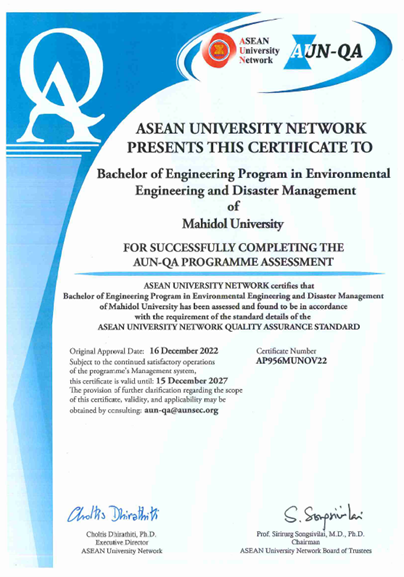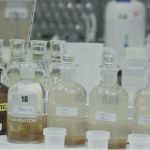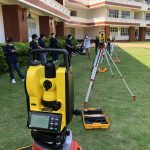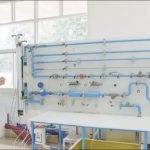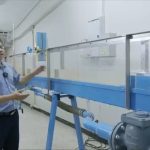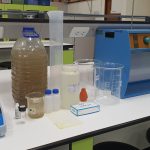|
MUGE 101 |
General Education for Human Development |
2 (1-2-3) |
|
The meaning, significance, and relation of General Education to other vocational/specific subjects; the relation between behavior and mentality; critical thinking; the qualifications of ideal graduates; analysis of causes and consequences of events/ situations/ problems; synthesis of solutions to, precautions against, or improvements in those events / situations to benefit individuals and their community; and the application of knowledge to solve the problems of case studies
|
|
MUGE 102 |
Social Studies for Human Development |
3 (2-2-5) |
|
Basic principles and theory in relation to events / situations / major problems of the Thai and global communities, for example, evolution of civilization; important events in historical, political and public administration systems; the economic and health systems, etc.; analysis of causes and consequences of events/situations/problems; synthesis of solutions to, precautions against, or improvements in those events/situations to benefit individuals and their community; and the application of knowledge to solve the problems of case studies
|
|
MUGE 103 |
Arts and Science for Human Development |
2 (1-2-3) |
|
Humankind in the past, present and future; events / situations / problems in relation to the evolution of the arts and sciences in the Thai and global communities; concepts of the sufficiency economy; analysis of causes and consequences of events / situations / problems; synthesis of solutions to, precautions against, or improvements in those events / situations to benefit individuals and their community; and the application of knowledge to solve the problems of case studies
|
|
KAGE 101 |
Interdisciplinary for Sustainable Development |
3 (3-0-6) |
|
Interdisciplinary; materials and methods in the participatory community study; communication with the community; principles of King Rama IX’s development works; concepts of the community development; the Philosophy of Sufficiency Economy; sustainable development; project-based learning
|
|
LATH 100 |
Art of Using Thai Language for Communication |
3 (2-2-5) |
|
Art of using Thai language and of speaking, listening, reading, writing, and thinking skills for accurate and appropriate communication
|
|
LATH 103 |
English Level 1 |
3 (2-2-5) |
|
English structure, grammar and vocabulary in the context of daily language use, dealing with integration in four basic skills (listening, speaking, reading, and writing); reading strategies, sentence writing, listening for the gist, pronunciation and classroom communication
|
|
LATH 104 |
English Level 2 |
3 (2-2-5) |
|
Vocabulary, grammar, and contextualized social language; essential communicative skills in small groups; simulations in various situations; writing practice at a paragraph level; and reading and listening from various sources
|
|
LATH 105 |
English Level 3 |
3 (2-2-5) |
|
Essential strategies for four language skills: reading and listening from various sources, speaking in everyday use and writing at a paragraph level and short essay, including sub-skills i.e., grammar, pronunciation, and vocabulary; focusing on English in everyday life and in academic reading and issues that enhance student’s world knowledge
|
|
LATH 106 |
English Level 4 |
3 (2-2-5) |
|
Reading passages and writing at sentence and paragraph levels about sequence of events and process, function, purpose, method and means, cause and effect, and conditional reasoning; academic English paragraph writing and an introduction to essay writing; listening comprehension; listening for the main idea; listening for specific details; and making inferences
|
|
KAED 101 |
Natural and Environmental Disasters |
3 (3-0-6) |
|
An introduction to earth science, climate and climate change; water cycle; natural disasters, flood, drought, seismic and volcanic hazards, tsunami, storm, forest fire, landslide and mudslide; epidemics of human and animal diseases; impact and risk from natural hazard; environmental disasters caused by human activities such as dam construction and spills of oil, chemicals or radioactive elements, etc.; disaster trends in Thailand and around the world
|
|
KAID 208 |
Probability and Applied Statistics |
3 (3-0-6) |
|
Classification of statistical methods; data collection, presentation and analysis; probability; random variable; discrete and continuous probability distributions; sampling and sampling distributions; estimation theory; hypothesis testing; analysis of variance; correlation and regression analysis; applications of statistics
|
|
KAED 212 |
Meteorology and Climate Change |
3 (3-0-6) |
|
Physics to explain the phenomena in the atmosphere, including solar radiation, air pressure, air mass circulation, the water system in the environment, atmospheric stability; the climate system; weather monitoring and forecasting; climate change and its effects; mitigation approaches; meteorology for air pollution simulation
|
|
SCPY 151 |
General Physics I |
3 (3-0-6) |
|
Mechanics, waves and optics; fluid mechanics; thermodynamics; electricity and magnetism
|
|
SCPY 152 |
General Physics II |
3 (3-0-6) |
|
Electronics; relativity; quantum mechanics; atomic physic; nuclear physics
|
|
SCPY 110 |
General Physics Laboratory I |
1 (0-3-1) |
|
Elementary level of experiments designed to accompany some topics in General Physics I, II (SCPY 151,152); laboratory examination is required
|
|
SCPY 120 |
General Physics Laboratory II |
1 (0-3-1) |
|
Experiments in electromagnetism, electronics, optic, acoustics and classical mechanics; types of errors; propagation of errors; standard deviation and standard errors
|
|
SCCH 113 |
General Chemistry |
3 (3-0-6) |
|
Basic knowledge about atomic theory; electron configuration; periodic table; chemical bonding; compound formation and their properties; properties of metals and semiconductors; states of matters and phase change; physical balance; phase diagram; chemical thermodynamics; chemical kinetics and chemical equilibrium
|
|
SCCH 118 |
Chemistry Laboratory |
1 (0-3-1) |
|
General techniques in chemistry; experiments on qualitative and quantitative analyses and some experiments related to lectures
|
|
SCMA 115 |
Calculus |
3 (3-0-6) |
|
Limit; continuity; derivatives of algebraic functions; logarithmic functions; exponential functions; trigonometric functions; inverse trigonometric functions and hyperbolic functions; applications of derivatives; indeterminate forms; techniques of integration, improper integrals; applications of integration; numerical differentiation and integration; calculus of two variable functions; algebra of vectors in three- dimensional spaces; calculus of vector-valued functions and applications for lines, planes and surfaces in three-dimensional spaces
|
|
SCMA 156 |
Ordinary Differential Equations |
3 (3-0-6) |
|
Complex variables; an introduction to ordinary differential equations; linear first–order differential equations; nonlinear first–order differential equations; applications of first–order equations; linear second–order differential equations; applications of second–order equations; higher order differential equations; systems of linear equations; matrices; determinants; vector spaces; linear transformations; numerical methods for solving linear algebraic problems; application in science and engineering
|
|
KAED 220 |
Engineering Mathematics |
3 (3-0-6) |
|
Engineering applications of ordinary differential equations; system of differential equations; mathematical induction; sequences and series of numbers; Taylor–series expansions of elementary functions; power series solutions of differential equations; Laplace transformation; Vector integral calculus; line integral; volume integral; polar coordinate; calculus of real-valued functions of several variables; numerical methods; engineering applications
|
|
KAED 121 |
Engineering Materials |
3 (3-0-6) |
|
Crystallinity and non-crystallinity of materials; imperfections in crystal structure; meaning and testing of materials properties; equilibrium phase diagram and its applications; macro and microstructures; properties and applications; production process; heat treatment; and applications of metals, ceramics, plastics, polymers, asphalt, woods, concrete and composites; an introduction to fracture, corrosion and degradation of materials; thermal, electrical, optical and magnetic properties of materials; case studies of materials selection
|
|
KAED 222 |
Engineering Mechanics |
3 (3-0-6) |
|
Force systems; resultant; equilibrium; fluid statics; kinematics and kinetics of particles and rigid bodies; the Newton’s Second Law of Motion; work and energy; impulse and momentum
|
|
KAED 224 |
Computer Programming |
3 (2-3-5) |
|
An introduction to computer concepts; computer components, hardware and software; hardware and software interaction; electronic data processing (EDP) concepts; an introduction to program design and implementation using a high-level language: types and expression, iterative and conditional control statements, functions, Boolean logic, array and record structures, pointers; an introduction to recursion
|
|
KAED 225 |
Chemistry for Environmental Engineering |
3 (3-0-6) |
|
Basic principles and calculations in environmental engineering; chemical equilibrium, acid-base, precipitation and dissolution; complex ion equilibriums; oxidation-reduction reactions; the carbonate system; aquatic chemistry; colloid chemistry; chemical and physical characteristics of water and wastewater; water quality parameters; water sampling and preservations; water and wastewater analyses in laboratory, such as pH, hardness, alkalinity, acidity, solids, dissolved oxygen, BOD, COD, nitrogen, phosphorus, etc.; basic chemical treatment processes, such as coagulation-flocculation and disinfection etc.; mass and energy balances; chemical kinetics; chemical thermodynamics; basic reactor models
|
|
KAED 226 |
Water and Waste Water Laboratory |
1 (0-3-1) |
|
Basic concepts of analytical chemistry; water sampling and preservations; expression of chemical analyses results; precision and accuracy of the analyses; laboratory techniques; water and wastewater analyses in laboratory: pH, hardness, alkalinity, acidity, solids, dissolved oxygen, BOD, COD, nitrogen, phosphorus, etc.; techniques for general microbiological analyses: sterile techniques, microscopic observation, dye staining, determination of coliform bacteria, etc.; data interpretation and application of data to environmental engineering practices: wastewater treatment systems and neutralization
|
|
KAED 227 |
Engineering Drawing |
3 (2-3-5) |
|
Using drawing tools; engineering lettering; applied geometry; theory of orthographic projection; orthographic drawing; sectional views drawing; auxiliary–views drawing; 3D–pictorial drawing; freehand sketching; dimensioning; abbreviations and symbols; reading engineering drawing; computer-aided drawing
|
|
KAED 228 |
Survey for Environmental Engineering and Disaster Management |
3 (2-3-5) |
|
An introduction to surveying work and basic field working; principles and applications of Theodolite: measurements of angle, distance and direction; errors and acceptable error; level loop adjustment in surveys; triangulation; precise determination of Azimuth; precise traverse plane coordinate system; precise leveling; topographic survey; map cartogarphy
|
|
KAED 229 |
Hydraulic |
3 (3-0-6) |
|
Fluid statics; fluids in motion and fluid flow principles; flow resistances; flow in closed conduits; flows in open channels; flow measurement; dimensional analysis and similitude; unsteady flow; mathematical equations on hydrodynamics
|
|
KAED 230 |
Hydraulic Laboratory |
1 (0-3-1) |
|
Laboratory experiments: hydraulic head losses in closed conduits, impaction of fluid jets, flowing affected by sluice gate and hydraulic jump, pipe flow measurement, the Bernoulli’s theorem, stability and buoyancy, flowing over sharp-crested weir and orifice, performance test of multi-pump sets, permeability and flow nets, flow measurement using Parshall flume, uniform open channel flow, forced vortex flow, centroid of hydrostatic pressure and flow velocity measurement
|
|
KAED 231 |
Microbiology for Environmental Engineering |
2 (2-0-4) |
|
An introduction to microbial metabolism and growth; the role of microorganisms in biological treatment; kinetics and stoichiometry of biological growth; microbial ecology and community in wastewater; relationships and roles of the bacteria on nitrogen, phosphorus and sulfur cycles; pathogenic bacteria and general biotechnology in environmental engineering
|
|
KAED 322 |
Environmental Unit Operations |
3 (3-0-6) |
|
Principles, calculation, designing and applications of physical and chemical unit operations in water and wastewater treatment: screening, grit removal, equalization, mixing, coagulation and flocculation, sedimentation, floatation, filtration, chemical precipitation, ion exchange, absorption and adsorption, and reverse osmosis
|
|
KAED 323 |
Environmental Engineering Laboratory |
1 (0-3-1) |
|
Skill practices of unit operations for environmental engineering in laboratory: sedimentation, filtration, coagulation, adsorption, absorption, electrostatics, ion exchange, activated sludge process
|
|
KAED 326 |
Hydrology |
3 (3-0-6) |
|
An introduction; hydrological cycle; precipitation; wind; evaporation; transpiration; infiltration/percolation; surface runoff; groundwater; sediment; reservoir; frequency analysis in hydrology
|
|
KAED 327 |
Biological Unit Processes |
2 (2-0-4) |
|
Fundamental of biological unit processes in wastewater treatment; fundamental of reactor engineering; kinetics of the biochemical system; mathematical modelling of ideal biochemical reactors; applications of the biological operations in attached and suspended growth systems by controlling food-to-mass ratio, sludge retention time, sludge volume index; aerobic and anaerobic processes in combined and separated operations
|
|
KAED 242 |
Occupational Health and Safety |
2 (2-0-4) |
|
Concepts and principles of occupational health and safety in compliance with occupational laws and regulations; investigating and assessing risk of occupational hazards; preventive measures and health promotion in the workplace
|
|
KAED 344 |
Solid Waste Engineering |
3 (3-0-6) |
|
Development of the municipal solid waste management system; sources, composition, quantities and characteristics of municipal solid wastes; onsite handling and collection; transfer and transport; processing and transformation technologies; source reduction and recycling; disposal of solid wastes and residual matters; incineration, composting and sanitary landfill
|
|
KAED 345 |
Disaster and Environmental Risk Management |
3 (3-0-6) |
|
Situations on disaster risk around the world; basic concepts and terminologies used in disasters and environmental risk management; disaster risk identification and assessment: hazards, local and social vulnerability, and adaptive capacity; disaster risk reduction; decision support tools for disaster risk reduction; disaster preparedness; principles and concepts on emergency response; disaster recovery; concepts and alternatives for financial risk management, such as disaster insurance
|
|
KAID 348 |
English for Environmental Engineering and Disaster Management |
2 (2-0-4) |
|
The development of comprehensive skills; English vocabulary for environmental engineering and disaster management; proper grammar usage; communication skill and basic report writing skill
|
|
KAED 349 |
Geo-Informatics for Environmental and Disaster Management |
3 (2-3-5) |
|
Principles of the geo-informatics system; the coordinate system; the global positioning system; spatial analysis; surface analysis; basic remote sensing; practices on using geo-informatics softwares to visualize spatial data and support decision in the field of environmental engineering and disaster management
|
|
KAED 351 |
Wastewater Engineering and Design |
3 (3-0-6) |
|
Wastewater characteristicsว wastewater flow rates; design of wastewater collection system: combined and separated sewers, pump and pumping stations; wastewater treatment and effluent standards; designs of physical, chemical and biological wastewater treatment facilities; disinfection; sludge treatment and disposal
|
|
KAED 354 |
Emergency Response |
3 (3-0-6) |
|
Definitions and types of crisis from natural hazards or industries; concepts and principles of safety and emergency response management; emergency preparedness plans; action plans on emergency response; decision making and complying with the plans; forming of emergency coordination centers and commanding system; ICT in emergency response; crisis management and rehabilitation; case studies of crisis management and emergency response
|
|
KAED 356 |
Laws and Engineering Ethics |
1 (1-0-2) |
|
Code of ethics for engineers; professional practices, duties and responsibilities as an environmental engineer; potential ethical issues in engineering fields; case studies of laws and penalties
|
|
KAED 442 |
Water Supply Engineering and Design |
3 (3-0-6) |
|
The importance of water; nature and water sources; water crisis; estimation of water demand according to requirement and consumption in the household, industrial, and public units; estimation of raw water in river, lake and groundwater; evaluation of surface water and groundwater qualities; standards and criteria for selecting water sources for water supply system; water supply standards; water treatment processes: aeration, pH adjustment, softening, coagulation, flocculation, sedimentation, filtration and disinfection; design of distribution system.
|
|
KAED 443 |
Environmental Management System |
3 (3-0-6) |
|
Basic concepts of the environmental system and issues on the management; prioritization; standards and criteria setting; indication and environmental indices; the informatics systems; measures on environmental protection using law enforcement and economic tools; the environmental management system (EMS) and ISO; surveillance; pollution prevention, Life cycle analysis (LCA) of services; products and organizations; environmental assessment tools, process and innovation; case studies
|
|
KAED 444 |
Water Resources Management and Hydrological Disaster |
3 (3-0-6) |
|
Problems on water resource management; principles of water resource management; farm-scale water management; project-scale water management; basin-scale water management; integrated water management, principles of sustainable water management; encountering during water crisis; water management in Thailand and international; models on water resource management; flood and drought control
|
|
KAED 445 |
Mathematical Modelling for Disaster and Environmental Management |
3 (3-0-6) |
|
Simulation; modelling; types of modelling; mathematical modelling for disaster forecasting and warning; hydrological modelling for surface water and ground water; fate and transport modellings for pollutants in air, water, and soil; water quality modelling; and land use change modelling
|
|
KAED 341 |
Building Sanitation |
3 (3-0-6) |
|
Fundamentals of building sanitation; laws and regulations; designs of water supply system, hot water system, sewer system, waste management, air ventilation, fire protection system, water drainage system and wastewater treatment system; alternative designs for sustainability; applications of environmental–friendly and energy–saving materials
|
|
KAED 352 |
Hazardous Waste Management |
3 (3-0-6) |
|
Definitions, laws and environmental legislations; classification of hazardous wastes; physicochemical properties, toxicology, types and characteristics of hazardous waste; risk assessment and management; handling and transportation; fundamentals of treatment and disposal processes; stabilization; incineration; solidification; land disposal; site remediation
|
|
KAED 353 |
Air Pollution Management and Control |
3 (3-0-6) |
|
Types of air pollutants and sources; effects on health and environment; principles of particulate and gaseous pollutant control; sampling and analytical methods; laws and regulations; principles and design of air pollution control units for particulate and gases; ventilation system design
|
|
KAED 455 |
Engineering Training |
1 (0-3-1) |
|
Training in the field of environmental engineering or disaster management in either private sectors or governmental agencies at least 240 hours in order to gain both academic knowledge and working experiences in organization
|
|
KAED 456 |
Engineering Project Proposal |
2 (2-0-4) |
|
Scientific research methodology for engineering projects; expression on rational and inspiration behind the engineering project; research and engineering ethics; structure of project proposals, techniques on reviewing literature from academic journal papers or other reference sources; selecting interesting topics related to environmental engineering and disaster management; basic skills on academic writing and presentation based on scientific rationale; and development of up-to-date engineering innovation and knowledge
|
|
KAED 457 |
Engineering Project |
4 (1-6-5) |
|
Studying the projects in response to the engineering project proposal; writing a report and presenting progress of the projects; summarizing and discussing reasonably on specific contents in the projects, writing final reports and presenting the final projects
|
|
KAED 458 |
Cooperative Education |
6 (0-18-6) |
|
Professional practicing as if full-time employee in the workplace not less than 16 weeks; working with the Mahidol University Kanchanaburi Campus’ partner companies to provide the students with opportunity to reinforce academic knowledge and working experience in the workplace; be able to develop skills in systematic thinking, observation, decision making, critical analysis and assessment; building up students’ capability to fulfill needs of entrepreneurs and market; be able to integrate routine findings into report format; conducting workplace-based operations research projects following research methodology, including data collection, experiment, data discussion, drawing to final conclusion and reporting
|
|
KAED 376 |
Forest Fire and Control |
3 (3-0-6) |
|
Definitions of forest fire; the impact of forest fires; policy on forest fire management; public relations for forest fire prevention; fuels; fire investigation; forest fire organizations; forest fire suppression plans; approaches and strategies for forest fire suppressions; benefits of forest fires; laws and regulations related to forest fire
|
|
KAED 378 |
Engineering Economics |
3 (3-0-6) |
|
A systematic evaluation on costs and benefits of engineering projects in consideration of “Time Value of Money” concept; discounted cash flow schematic diagram; and decision making on the project regarding to financial parameters; and applications in the engineering projects
|
|
KAED 381 |
Soil Pollution Management |
3 (3-0-6) |
|
Soil pollutants from natural and human activities; sources and characteristics of soil pollutants; transports and dispersions of the pollutants in soil; transformation processes of the pollutants in soil; planning on soil pollution remediation and methods of soil pollution remediation; laws and regulations relating to soil pollution
|
|
KAED 382 |
Renewable Energy for Sustainable Environment |
3 (3-0-6) |
|
An introduction and environmental impacts of energy derived from fossil fuels and other available sources nowadays; sources, significance, basic principles, current researches and innovations, as well as case studies of technologies on alternative energy sources: hydro energy, solar energy, wind energy, geothermal energy, biomass and bio-energy (e.g., biogas, ethanol, and biodiesel) in Thailand and worldwide; assessment on utilizations of natural resources and waste and reductions of energy cost for sustainable environment
|
|
KAED 383 |
Basic Eco-Product Design |
3 (3-0-6) |
|
An introduction to eco-design and development of environmental–friendly products; the design review system; identification of customer needs and market research; design for sustainability; biomimicry; basic manufacturing processes; techniques to enhance creativity; fundamentals of 3D modelling; case studies
|
|
KAED 384 |
Noise and Vibration Control |
3 (3-0-6) |
|
Principles of sound wave; instruments and measurements of noise and vibration; sources and impacts of noise and vibration on human health and environment; physiological and mental responses to noise and vibration; laws and regulations; techniques used for noise and vibration control in the environment; uses of acoustic materials and barriers
|
|
KAED 385 |
Environmental Impact Assessment |
3 (3-0-6) |
|
Concepts of environmental impact assessment and analytical methodology; assessments of physical resources: air, water, noise; assessments of ecological and biological resources; human use values and quality of life values, culture, socioeconomic; interrelationship of engineering benchmarks and environmental parameters; planning the environmental quality evaluation; monitoring; prevention and mitigation measures; establishment and organization of environmental agencies; industrialization and urbanization management; resource conservation; management approaches and program implementation; case studies of environmental impact assessment and specific environmental protection
|
|
KAED 482 |
Remote Sensing for Disaster Management |
3 (3-0-6) |
|
Remote sensing concept; electromagnetic radiation principles; earth–observing platforms and data recording system; satellite imagery interpretation; remote sensing techniques for detecting vegetation, water and soil; digital image processing; image preprocessing; image enhancement and transformation; data classification; applications of remote sensing for disaster management
|
|
KAED 484 |
Fire Engineering |
3 (3-0-6) |
|
An introduction to fire engineering; fire safety; human behaviors; fire suppression; smoke control and management; fire dynamics and modelling; risk analysis in building fire safety; water–based fire protection system; economics of fire protection; laws and technologies; evacuation; fire investigation; and fire department operations
|
|
KAED 485 |
Project Administration |
3 (3-0-6) |
|
Specific characteristics of projects; project administration cycle; project selection; project definition and project planning; project organization; work breakdown structure; project estimation; project dependency; work plan; Gantt chart; critical path; resource planning; budget planning; risk administration; and problem management; project monitoring and control; project auditing; project closure; roles of project managers on team management
|
|
KAED 486 |
Waste Utilization Technology |
3 (3-0-6) |
|
Engineering principles of waste reuse and recycle; characteristics of organic wastes, composting; anaerobic digestion; biomass and biofuel production; environmental and social impact of recycling process; management of organic waste recycling programs
|
|
KAED 487 |
Biomass and Bio-Energy Technology |
3 (3-0-6) |
|
Types, characteristics, physical, chemical, and biological properties of biomass as raw materials for energy production and bio-energy products (e.g., biogas, ethanol, biodiesel, bio-oil, syngas, and biochar); basic principles and reactions in biomass-to-energy conversion processes: bio-chemical, physico-chemical, and thermo-chemical reactions; assessment and selection of suitable biomass for specific technologies; feasibility of applying bio-energy production into industrial scale in consideration of economic feasibility and current situations in Thailand and worldwide
|
|
KAED 488 |
Membrane Technology for Water and Wastewater Treatment |
3 (3-0-6) |
|
Membrane technology; principles of filtration by membrane; properties of membrane; type of membrane; membrane modules; pros and cons of membrane technology, factors influencing membrane filtration; the factors affecting membrane fouling; fouling control; fouling removals; applications of membrane technology to productions of tap water and drinking water and treatments of domestic wastewater and industrial wastewater
|
|
KAED 489 |
Advanced Water Treatment Processes |
3 (3-0-6) |
|
Fundamental principles of advanced wastewater treatment; advanced oxidation processes (AOPs); applications in contaminant removals from wastewater; and nanotechnology related to advanced oxidation processes; ion exchange; reverse osmosis, tertiary biological treatment for nutrient removal (BNR); anaerobic treatment of industrial wastewater
|

